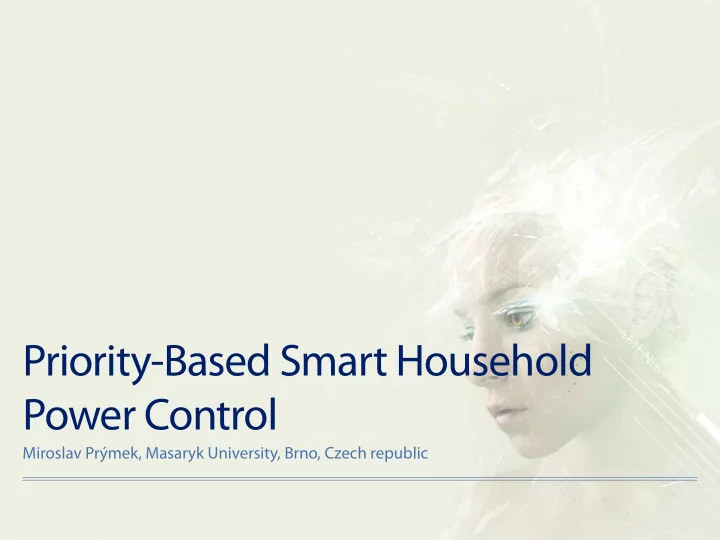

Priority-Based Smart Household Power Control Miroslav Prýmek, Masaryk University, Brno, Czech republic
aim & motivation ‣ harmonize power supply & demand by control on the consumption side ‣ small scale - household, block of houses ‣ cheap, simple, robust ‣ yet intelligent ‣ using existing technologies, but only open ones
supply/demand coupling - market models ‣ perfect but ‣ hard to compute ‣ latency ‣ extensive communication ‣ complicated logic ( → user cofigura tion! ) ‣ hardware requirements
priority-based model ‣ supply power to appliances according to the actual demand priority ‣ overall system behavior formed by the priority-changing rules ‣ rule sets can be designed to suit the particular appliance nature - from really simple reactive-only ones to intelligent control ‣ → keeps hardware requirements as low as possible
model - appliance types ‣ interactive appliance (directly controlled by the user) ‣ intelligent interactive appliance ‣ deferrable-operation appliance ‣ feedback-controlled appliance
interactive appliance ‣ switched only on/off ‣ by the user ‣ mostly unpredictable ‣ instant reaction needed ‣ reactive agent, high priority, simple control, simple communication ‣ lights, kettle, TV
intelligent interactive appliance ‣ usually cannot react instantly (would you just cut the PC power off?) ‣ but power control is more fine-grained than on/off ‣ usually supports some kind of scheduling ‣ requires more complicated communication and logic ‣ PC
deferrable-operation appliance ‣ user expects the result, not the activity ‣ the result is expected “in a short time” , but not “precisely now” ‣ other non-crucial properties: interruptible, power profile controllable, ... ‣ washing machine, dryer, dishwasher, slow cooker, ...
feedback-controlled appliance ‣ the appliance tries to keep some value in the predefined bounds ‣ classical control: regular oscillation between the bounds ‣ but regularity is not strictly needed → we can get flexibility Priority ‣ power demand priority rises with the distance from the desired value °C no power accumulated 22 ‣ “power accumulator” 6 6 r e f r i d g 5 e r a t i o n 5 r e f conventional r i d g 4 operation e r a t cycle i o n 4 3 3 maximal power accumulation 0 Time
scheduling demand 1 500 W cumulated demand 100W 400 UPS/generator demand 2 300 100W X 200 grid available power X demand 3 100 100W priority photovoltaic time time matching demand 4
examples sun peak normal cumulated demand use cheaper power first ‣ peek elimination (1) ‣ disasters: eliminate ‣ unnecessary grid blackout X consumption (2) X eliminate excessive ‣ X production X priority 2 1 X 3 available power time 2 3 1
prototype implementation RS485 Atmel AVR ~ $3 ~ $2 custom open extensible protocol
prototype implementation Erlang
thank you
Recommend
More recommend